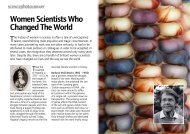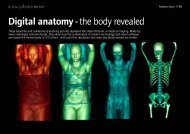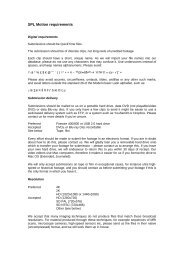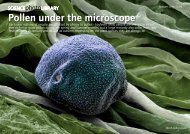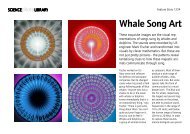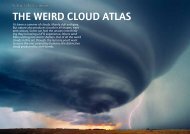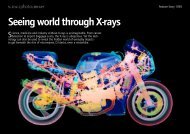ANIMAL SUPERSENSES - Science Photo Library
ANIMAL SUPERSENSES - Science Photo Library
ANIMAL SUPERSENSES - Science Photo Library
You also want an ePaper? Increase the reach of your titles
YUMPU automatically turns print PDFs into web optimized ePapers that Google loves.
<strong>ANIMAL</strong> <strong>SUPERSENSES</strong>When it comes to sensing the world around us, human beings have it pretty poor compared to most of the animalkingdom. For example, our eyes can only detect a fraction of the colours that birds can see and our ears can’t hearvery high frequencies like bats or dogs. Similarly, our noses need to be bombarded with odours before detecting anyscent, compared to moths, which can detect individual molecules.Feature Story 1180
<strong>Science</strong> <strong>Photo</strong> <strong>Library</strong> Feature Stories - Animal supersensesWe make up for our limited sensory abilitiesby inventing equipment like sensors,detectors, GPS, sonar, night vision goggles andthermographic cameras. But it seems evolutionis one step ahead, endowing bats, birds, fishand even insects with far more efficient naturalpowers. Taking a closer look at these ‘supersenses’ may help us to build better technologyand lead to discoveries about hidden supersenses of our own.TouchIn habitats where normal vision or hearingmight be obscured, an enhanced sensitivityto touch is vital for survival. Most mammals,and some birds, have long hairs on their facesknown as whiskers, or vibrissae. These hairsare extremely sensitive to touch. The smallestdeflection of the hair shaft causes the nerves atthe base to register movement. Some animals,such as mice, are so sensitive they can evendetect tiny air movements.For fish, living life underwater mean vibrissaewould not be much use. Instead, they haveevolved specialised hair cells along the lateralline of their body that can detect water currentsor motion.Sharks have evolved an even more sophisticatedset of sensing tools. Located within thesnout are electrically sensitive cells knownas the ampullae of Lorenzini. These cells candetect weak electrical impulses in the waterthat are generated by the muscle contractionsof other fish. The ampullae of Lorenzini arealso thought to assist sharks with geomagneticnavigation and sensing water temperature andsalinity. Human divers have learned to takeadvantage of the shark’s electrosensitivity bydeveloping electronic shark repellents.HearingDogs can hear sounds beyondthe range that we humans canhear. Trainers utilise this abilityby using dog whistles that emit ahigh-pitched sound. These whistleshave a frequency range ofbetween 16,000 to 22,000 hertz(Hz) - most sounds are inaudibleto the human ear beyond20,000 Hz. At the lower endof the sound spectrum, whalesuse very low frequency soundsto communicate with eachother over hundreds of milesof ocean. Studies of Humpbackwhale songs reveal that duringthe mating season, males emita complex series of repeatingsounds with a frequency rangefrom 20 Hz to 10 Hz. Since the human ear canonly hear down to 20 Hz, researchers must usespecial underwater microphones that are sensitiveto this range.Whales and dogs certainly possess supersensitivehearing but there are a group of animalsthat use sound in a completely different way.Dolphins, bats, shrews and oilbirds are able toemit a rapid series of high frequency clicks andlisten for the echoes that bounce or reflect off anearby surface. This amazing ability allows theanimal to work out the location and size of objectsand prey in complete darkness. The abilityis known as biosonar, or echolocation. Bats canemit noises in ultrasound, up to 100,000 Hz,and at speeds of 200 clicks per second, enabling them to hunt prey as small and speedy asmosquitoes. Dolphins are also sophisticatedusers of biosonar. Experiments have shown thatthey can tell the difference between a golf balland a table-tennis ball using biosonar to sensethe different densities.Echolocation used to be thought of as uniqueto only a few animals, but the case of BenUnderwood, a blind teenager from the US, whois able to walk, run and even skateboard freelyby using vocal clicks and listening to echoes,highlights an amazing example of the potentialfor hidden super-senses amongst humans.VisionScientists believe birds have the most advancedvisual system of any vertebrate. They seecolours over four wavelengths of light, so-calledtetrachromatic vision, compared to most humanretinas, which can only detect three wavelengths.This fourth light detector is sensitive tothe ultraviolet (UV) part of the spectrum, whichhumans can only detect with special equipmentor photographic techniques.UV vision opens up an unimaginably richvisual world that has important implicationsfor survival. To a female pigeon or peacock, thetetrachromatic display shown by the plumageof the male bird reveals subtle patterns andmarkings that allow her to select the best mate.UV sensitivity can also help when hunting forfood. Kestrels hovering high in the air are ableto spot the UV-reflecting urine trail of a smallrodent and many songbirds are able to spotfruit berries, which reflect UV light strongly.Bees, wasps and other pollinating creatures alsohave UV vision. They can detect invisible ‘honeyguides’ on flowering plants .Recently, researchers have discovered a tinyminority of humans with a genetic mutationthat allows them to see in tetrachromatic vision.Their ‘fourth’ colour receptor is not UV sensitivelike birds, but it still allows them to see coloursmore richly than the rest of us.Super-sharp vision is the hallmark of birds ofprey such as eagles, vultures and owls. Theirability to spot small prey from long distances relieson several visual enhancements. These birdshave eyes that face forward (binocular vision) togive overlapping fields of view and great depth.A large lens magnifies and processes light veryefficiently. Finally, birds of prey have an extremelydense region of light-collecting cells onthe retina. The buzzard, for example, has over amillion light sensitive cells – five times as manyas humans.For humans to see in the dark, we need to relyon high-tech night vision goggles. Nocturnalanimals have their own inbuilt night visionsystem. Owls, for example, have huge eyes inproportion to their head size. The eyes are tubularrather than round, giving telescopic vision,which allows more light to enter and provides alarger surface area on the retina. Owls can alsocompletely open the pupils of their eyes, so thatno iris is visible, which maximises the amountof available light hitting the densely packedretinas. Owl night-vision is 100 times moresensitive to low light than our own. But theydo have their drawbacks. Owls are long-sightedand the eyes do not move in their sockets. Tocompensate, they have flexible necks that allowthem to turn 270 degrees left or right, or up to90 degrees vertically.Some owls have an additional eye structure,shared with many other nocturnal animals. Thisis a highly-reflective layer of tissue behind theretina known as the tapetum lucidum. A cardriver at night who catches a rabbit, deer or
<strong>Science</strong> <strong>Photo</strong> <strong>Library</strong> Feature Stories - Animal supersensescat in his headlights will see a pair of glowingeyes. Of course, the eyes do not actuallyglow. It is the layer of tapetum lucidum tissuebehind theirretinas thatintensifiesany availablelight andreflects itback to theretina. Forthe predatorit enhancesnight visionto hunt forprey, andfor thosehunted, itgives thema chance tospot danger.Humans donot havea tapetumlucidum.Heat senseSnakes are one of the most successful animalson the planet. Endowed with poisonous venomand unencumbered by limbs, evolution hasgifted some snakes with yet another supersense – the ability to see in infrared.Pit vipers are so-called because of pit organslocated just below the eye. Each pit containsthermoreceptors - infrared sensing cells whichare able to detect prey due to the tiny temperaturedifference between the animal’s body andthe cooler environment. The pit organs are morethan just simple heat sensors, as the snakes arealso able to gauge depth, allowing them to accuratelystrike their target in complete darkness.The Melanophila acuminata beetle seeks outheat for a differentreason to pitvipers. It prefersto lay eggs onthe charredremains of woodfrom forest fires.These trees offerno resistance in the form of sap or sticky fluidsthat might hinder the beetle. Located on thebeetle’s underbody are specialised heat-sensingcells known as sensilla that excite nerve cellswhenever infrared radiation from a nearby forestfire is detected. Scientists have revealed thatthe sensilla can locate fires up to 12 kilometresaway. These remarkably sensitive natural heatreceptors are now being researched by themilitary and industry to produce better firedetectors and heat-imaging systems.Smell & tasteThe senses of taste and smell are closely linkedin humans - most food tastes are based on aromaticcompounds initially detected by the nose.Animals are able to ‘taste’ the air for subtleodours associated with food or mates by usingvery sensitive receptors on their vomeronasalorgan. This organ, found within the mouth ofmost vertebrate animals, has to be exposed tothe air for the animals to sense the odours. Sowhen cats ‘sneer’ and raise their lips or whensnakes whip out their tongue, they are exposingtheir vomeronasal organ. Humans also possessa vomeronasal organ but scientists believe thatit has lost nearly all of its functioning ability.An exquisite sense of smell is not restricted tovertebrates. Bloodsuckers such as mosquitoesand ticks are incredibly sensitive to the presenceof carbon dioxide (CO2) breathed fromthe lungs of their quarry.Scientists have recentlyidentified the specialisedreceptor proteins locatedon the surface of olfactoryneurons that detect theminute concentrationsof CO2. This discoverycould one day lead tonew agents to control thespread of disease-carryinginsects such as the malariamosquito.For male moths, loveis in the air when theirfeathery antennas detecttiny amounts ofa class of chemicalsknown aspheromones.Moths don’thave noses butinstead ‘smell’by using theirantennas to trapminute quantities of pheromones.Female moths release pheromonecompounds from special glands atthe tip of their abdomen. Just a coupleof molecules of these landing onspecialised sensing cells on the maleantenna is enough to provoke themale moth into a sexually chargedfrenzy. Some researchers believe thathumans also produce pheromones toattract the opposite sex.NavigationThe long distance migration of animals such assea turtles, songbirds, Monarch butterflies andAtlantic salmon in the quest for new feeding,breeding or sheltering grounds is one of themost spectacular events in nature. Many animalspecies travel enormous distances. The arctictern holds the long-distance record, covering20,000 kilometres in one year from theArctic to the Antarctic and back again. Youngsalmon swim hundreds of kilometres from theirfreshwater spawning grounds to reach theocean, only to return to exactly the same spotas adults. And Monarch butterflies, althoughseemingly fragile, are actually confident flyers,able to migrate across almost the entire NorthAmerican continent.These animals do not have access to compasses,satellite navigation, survey maps, radar orany of the multiple tools that we use. How theymanage their amazing journeys without losingtheir way has baffled scientists until relativelyrecently.The answer lies with two super sensingabilities – polarised light vision and internalmagnetic receptors. Polarised light is light thatvibrates in one plane relative to the direction ofthe source. When the sun is low on the horizonat dawn or dusk, there is a band of intensepolarised light 90 degrees from the sun passingdirectly overhead through the zenith whichintersects the horizon 90 degrees to the rightand left of the sun. The human eye cannot seeit, but birds and butterflies can and scientistsbelieve that this intense band of polarised lightacts as an accurate reference point for migratinganimals.Migratory animals may also use an internalmagnetic compass for navigation. Recent
<strong>Science</strong> <strong>Photo</strong> <strong>Library</strong> Feature Stories - Animal supersensesFor drivers, in-car navigation meanswrong directions are much less likely.In terms of accuracy, convenienceand accessibility, GPS can definitelybe said to match the most impressivenavigation skills of long distancemigrating animals.8.Ultrasound.The human ear can hear sound infrequenciesranging froma low 20 Hzto an earpiercing highof 20,000 Hz.Bats easilybeat that byhearing ultrasoundsupto 150,000 kHz. Simple bat detectorscan convert bat ultrasound noises intosounds audible to the human ear. Butvery high frequency sound waves canalso produce images that we can see– ultrasound images of the unbornfoetus is one example. Ultrasound isalso used for a variety of medical andindustrial diagnostic imaging andeven for cleaning complex components.Given the degree of successwith using ultrasound frequencies,technology beats nature in thiscategory.9.UV vision.Ultraviolet radiation can help andhinder human lives. UV rays from theSun causes skin damage, but UV lightis used to help identify fraud, hardennew tooth fillings, spot fluorescingproteins in biomedical research andaid forensic examination of crimescenes. Ultraviolet sensors can alsolook down on Earth to see ozone holesand dust storms or far into space tosee cosmic structures that visible lightdoes not show. The diverse array oftechnologyutilisingUV lightmeanstechnologybeatsnature…butwouldn’t itbe amazingto see the world in tetrachromaticcolour as birds do?10.Touch.The human sense of touch is actuallyverysensitive – totexture andtemperature.Witness thefluency ofa braillereader to seehow humantouch canadapt andbecome verysensitive.But for remote sensing, we need torely on mechanical technology such asseismographs to detect earthquakesor laparoscopes for delicate medicaltechniques and robotic arms to handledangerous materials. The cat’s whiskeris far more finely attuned to subtlemovements and so must beat technology’sattempts at enhanced touch.ENDS 915 WORDS ©2007 SCIENCEPHOTO LIBRARY
FULL PICTURE SETFor captions and credits, please refer to the captions.txt file<strong>Science</strong> <strong>Photo</strong> <strong>Library</strong> Feature Stories - Animal supersensesFor further information, please contact: seymour@sciencephoto.comAll images are copyright, please credit images as stated on the captions
<strong>Science</strong> <strong>Photo</strong> <strong>Library</strong> Feature Stories - Animal supersensesFor further information, please contact: seymour@sciencephoto.comAll images are copyright, please credit images as stated on the captions



